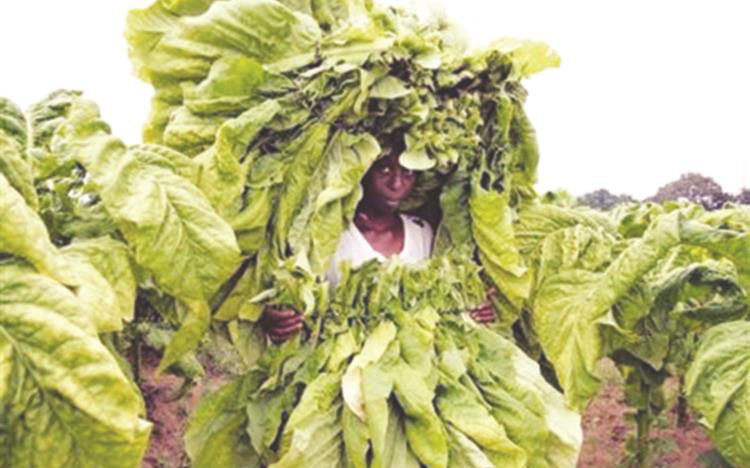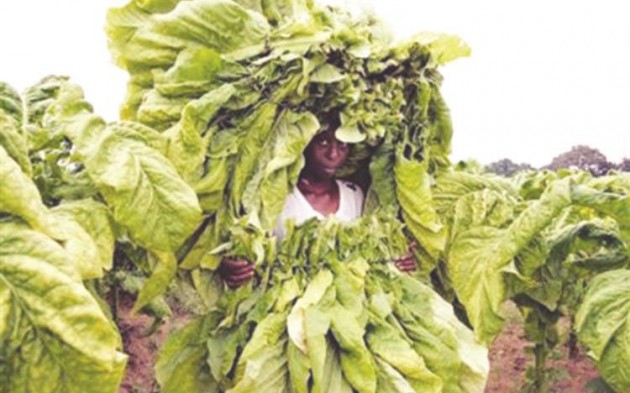Getting agric moving: Finance and credit


Contract farming has been the lifeblood of Zimbabwe’s agriculture, particularly tobacco, in the absence of loan finance
Ian Scoones Correspondent
GETTING the agricultural sector financed is a key challenge in Zimbabwe, and links concretely to land administration challenges discussed in previous blogs in this series. Making both places and people bankable is a priority, but responses have to be geared appropriately to different scales of farm operation (A2 and A1), as well as linking macro responses at the economy-wide level with regional, district and farm level responses. There are a number of dimensions to this context in Zimbabwe.
Political economy contexts
There are significant political dimensions to financing in Zimbabwe. Flows of finance and credit to the Zimbabwean economy have been heavily affected by the political relations between the Zimbabwean state and others over the last 17 years. The intermittent engagement with the International Finance Institutions due to outstanding debt arrears, and ongoing restrictive measures around Western donors working in “contested areas”, where compensation claims have not been settled, has influenced what amount and what types of finance are available. The Zimbabwe Government’s own economic management decisions have often not helped either.
This macro-economic picture in Zimbabwe is dire – and has been for years. The formal economy went through an extreme collapse in the 2000s with the withdrawal of international finance, through a tentative recovery facilitated by currency stabilisation following 2009. The current cash crisis, a consequence of a combination of factors, and the strong regional demand for US dollars, has compounded things seriously, making business – including farming – very tough.
Furthermore, alternative finance from China and elsewhere has not been forthcoming. Acknowledging debts and liabilities generated by the land reform (see blog on compensation) is an essential precursor to moving forward; otherwise land reform areas will continue to be seen as high risk areas for financing.
The current international re-engagements around fiscal management and other structural reforms, including the agreements around restructuring the debt/arrears, offer opportunities if all sides of the bargain are kept. Addressing debt suggests a framework within which the compensation issue could be addressed.
Over the last 17 years there have also been indirect effects of the macro-economic situation on land investment. This is particularly apparent as marketing and input supply intermediaries have been unable to get finance, as international risk ratings have remained high, and international loans for financing new operations have not been forthcoming.
High interest rates, and so the high cost of money, have fed into this, resulting in illiquidity and a severe shortage of low risk cash for financing agriculture. The demand for financing in all sectors is so high that financiers prefer to lend into lower risk and high, immediate return areas (e.g. mining, and some retail operations, for example), with the result that there is little left over for financing agricultural investment. Re-engagement becomes critical to increase liquidity in the bank/finance sector, and so to shift interest rates and money supply.
A role for parastatals?
A particular feature of the macro-economic collapse has been the disappearance of a bond market. In the past the Agricultural Marketing Authority (AMA)used to issue State-guaranteed bonds that provided finance to the GMB, CSC, Cottco and other parastatals. The parastatals then took on an important role in market coordination and financing, including a variety of loan schemes for both small- and large-scale farmers.
Large-scale farmers, for example, were able to take out three-month credit lines, with discounts on the volume of inputs procured. The Cold Storage Commission/Company used to finance local auctions and markets, and facilitate rural marketing. In the liberalisation era, parastatals went out of fashion, and their role declined.
This was combined with a range of poor management and investment decisions, as well as growing corruption. The CSC focused efforts on the export market and large-scale beef production and invested in a series of costly white elephant abbatoirs. While Cottco was privatised, others such as Grain Marketing Board remained under public control, and became a key state agency for “command agriculture” in the 2000s.
Today parastatals cannot raise meaningful funds on local bond markets, and certainly cannot rely on Treasury finance. Instead they must seek other partnership financing from the private sector. This is witnessed in the expansion of privately-run agribusiness operations on parastatal land, with over 20 new projects in train; some on a very large scale with significant capitalisation, and involving both local and foreign investors.
This may help generate new forms of viable operation, but this removes parastatals from the wider social and market coordination role that used to be played, while the wider social benefits of such new investments have yet to be seen. A few banks (CBZ, Zimbank) and the AMA have raised limited money via agro-bill bonds, but the credit supplied remains on very high interest rate.
Contract farming
There are particular financing problems in agriculture, and these often vary according to the type of commodity. Even at the height of the economic crisis in the 2000s, export crops were able to take off, as external finance, often from China, India and other non-Western countries, became available. Thus the investment via Tian Ze (and China Tobacco, a state-owned company) was vital for the growth of tobacco contracting in the early 2000s, including on land reform areas.
This was facilitated by the Zimbabwean State, through foreign currency retention incentives, permits to purchase tobacco outside auctions, subsidised seed multiplication through the Tobacco Research Board, and significantly via the Tobacco Industry and Marketing Board, as new regulations were put in place that facilitated contracting arrangements.
Investment in cotton contracting in smallholder areas, including A1 farms, continued from the successful take-off in the 1990s following liberalisation, with even more players entering the ginning and contracting buying market in the 2000s and following land reform, although cotton companies have faced major challenges through a combination of side-selling and the decline in international cotton prices in recent times.
These export cash crop operations were able to continue because of the appropriateness of the crop to smallholder conditions (unlike tea and coffee, for example), and the ability of companies to shift to contract farming arrangements and the ability to sell products in hard currency externally.
This form of cash crop contracting has become a vital form of financing in land reform areas in general, with the tobacco boom being the most celebrated example. As the economy stabilised, other contractors/buyers (including Western companies) have returned, but now in a much more competitive setting, and heavily constrained by the economic environment, not least the lack of cash.
Some crops that were formerly grown on contract on large-scale commercial farms were not so easily transformed under the post-land reform setting. Large-scale export horticulture/floriculture is a case in point, where in the past very high-tech, just-in-time operations were linked to supermarket/broker purchase in Europe, usually under stringent standards (as in GlobalGap), and these could not be replicated by new farm owners.
The operations were equally tied into complex financing and insurance arrangements that the large buying companies (in Holland, for example, for flowers and vegetables) were unwilling to reinstate due to potential risks, and increased costs due to the withdrawal of direct air freight routes to Europe.
Today, however such value chains are being re-invented for the new situation, with new models for outgrowing, contract purchase and financing being defined through a variety of business arrangements. Thus for smaller farmers operating on contract and producing certain crops, financing via contract arrangements rather than direct loans from banks has become an important route to land investment – although as discussed in other blogs not without challenges. Many such farmers mix contracting with direct sales and self-financing, as the terms of contract financing are not always favourable.
However, this does not apply to all crops, and contract eligibility restricts access for some. In addition to tobacco and cotton, that are now well-established contract crops, there are some other crops where contracting is developing, usually associated with a particular buyer. This includes paprika, potatoes (for chips/restaurants), and barley and sometimes sorghum (for brewing). Some attempts have been made to finance maize production under contracts, but this has been limited, as millers have been able to source cheaper product from outside the country.
Contracting arrangements in livestock systems are less developed, but may involve the financing of livestock owners by abattoir owners, for example, to fatten and deliver animals to particular outlets. This is more prevalent in poultry production, where “outgrowers” are linked to the supply of day-old chicks, feed and veterinary supplies.
However, while contract farming with small-scale producers has been important, it has also had problems, notably through side-selling and the assurance of contracts. This has undermined the business viability of some operations, requiring Government regulation in contract markets.
Financing for small-scale farmers outside contracting is highly restricted. Few small, $1 000 loan options are available. There are some examples of collective arrangements for raising funds and savings, including credits cooperatives and savings clubs, and some of these are supported by NGOs and churches in communal areas, but they have had little impact in the resettlement areas.
Asset loans, such as chickens, may not hit the mark. Since the group lending approaches of the 1980s, there has been little experimentation with credit, and the collapse of such schemes through the demise of the Agricultural Finance Corporation in the late 1980s. The failure post structural adjustment in the 1990s to replace this system means that there is remarkably little accumulated experience of small-scale credit arrangements in Zimbabwe, in contrast to other countries in the region, and certainly Asia.
Partnership finance: joint ventures
Partnership-based finance through joint ventures is another route through which funds can be raised. A joint venture is distinct from a share-cropping arrangement and is permitted under proposed new legislation. This includes where external financiers and former farmers who go into business with larger farmers, and the farm operation becomes a joint venture company. This is occurring in production, as well as processing and marketing, and is an important route to refinancing, where risks are spread as part of the joint venture agreement.
Joint ventures and partnership finance is increasingly seen as a route for rehabilitating and investing in State farms. A number of examples exist, including the now famous Chisumbanje sugar mill and plantation on an ARDA estate. Indeed, around half of ARDA farms are now run with private sector partners, and similarly investors into CSC farms are unfolding, reminiscent of the notable DMB operations (financed through CDC) during the 1980s. This may in time be linked to outgrower arrangements (as envisaged for Chisumbanje) as a core estate operation is developed through external finance, but remains under State control. With the lack of financing for parastatals (see above), these partnership arrangements have become vital for parastatal operations of many sorts.
Bank finance
For larger scale farmers, joint ventures and contracting, however, may not be the route they want to follow, and financing has been a major constraint, especially since 2000. Surveys show repeatedly that many A2 farms are undercapitalised with low levels of production, and sometimes significant land underutilisation. This has been a direct consequences of the macro-economic situation feeding through to financing options, despite various Government schemes to support loans for farm equipment, etc.
Some are able to fund farm operations from other work (for example, A2 farmers who have jobs as civil servants or in businesses) or through remittances (particularly from abroad), as well as through vertical integration of business (linking an A2 farm with abattoirs, supermarkets and so on).
However such financing is relatively small, and not sufficient for major take-off especially in farm operations that require rehabilitation and recapitalisation. Significant but quite inadequate and irregular amounts of credit for irrigation equipment and farm mechanisation have been raised through lower cost external tied loans (e.g. US$98 million from Brazil through the More Food International programme, based on low interest payment over 15 years) using Agribank as one key conduit.
For most A2 farmers, bank finance is essential. This has been largely unavailable. It has also been restricted by the delayed issuance of leases, and their wording. Although land can be mortgaged, the phrasing of the first version of the lease contract presented the lease as State property that could not be sold or sub-let. It is therefore not clear how the land could be foreclosed to recover unpaid loans, and this undermined transaction possibilities for lenders.
Procedures for bringing in an alternative lessee were also not clear. As many have argued, a revision of the lease wording is a crucial policy revision to balance the ability for the lease to form collateral in loan arrangements with banks, while allowing the State regulatory oversight to address its fears of the re-concentration of landholdings. The balance in safeguarding the security of loans and investment has been achieved in many other leasehold-based property systems, although these experiences do not seek to regulate land concentration.
Zimbabwe could replicate the tested lease regulations that safeguard bank mortgage finance, and find innovative but competitive ways of auctioning foreclosed lands in a way that safeguards against multiple farm ownership. Moreover, the State is ultimately the guarantor as owner of the land, and can take back the land and compensate for improvements (paying any debts in the process), but this procedure would have to be specified.
With this finance institutions, assuming improved liquidity, will be able to enter the land/agriculture financing market with lowered risk. There are a diversity of views on such proposals within the banking sector. Facilitating an effective discussion with Government on rural financing is a high priority, given the banking sector’s potentially important contribution to agricultural and rural development.
For all farmers, there are of course forms of collateral beyond land. New approaches to financing has been encouraged through the Moveable Property Security Interest Bill. While ridiculed in the international press as banks accepting cows or goats as payment, it makes a lot of sense. But many banks have often reacted in a typically conservative fashion, basing assumptions on past practice rather than wider experience of a more flexible approach to collateral.
Again the obsession with freehold title discussed in last week’s blog rears its ugly head. In terms of alternative collateral systems, mortgageable properties may be important as can moveable assets such as farm equipment, vehicles and livestock as specified in the Bill. Mortgages can be issued with hire purchase arrangements embedded – for example for the purchase of equipment – and warehoused commodities can be offered as commodity-based collateral, for example. As international experience shows (see below), private banks and finance houses can make use of rather more diverse ways of gaining security around loans than is currently being offered.
Agricultural financing for land investment: a complex challenge
In many respects the often obsessive focus on land as collateral in the Zimbabwe debate is only a small part of a bigger and more complex story of agricultural financing for land investment, one that has barely been explored in post-land reform setting. The largest amount of funding for land reform farmers comes from contracting, with an increasing array of joint ventures emerging on A2 farms. As discussed last week, all of this must be seen in the context of wider, incomplete efforts at macro-economic reform and support for the revitalisation of the economy.
Restrictions on financial flows, resulting in liquidity problems, high interests, the collapse of bond markets, and lack of international finance opportunities, as well as the flow of credit and finance away from agriculture, have severely restricted agricultural recovery. Resolving land issues – including accepting liabilities for compensation, revising lease terms, and developing regulatory frameworks for financing – is a core part of the macro-economic agenda, and central to finding a way forward for Zimbabwe.
This post was prepared by Ian Scoones and appeared on Zimbabweland. It is part of an occasional Zimbabweland blog series on priorities for the new Zimbabwe Land Commission.









Comments